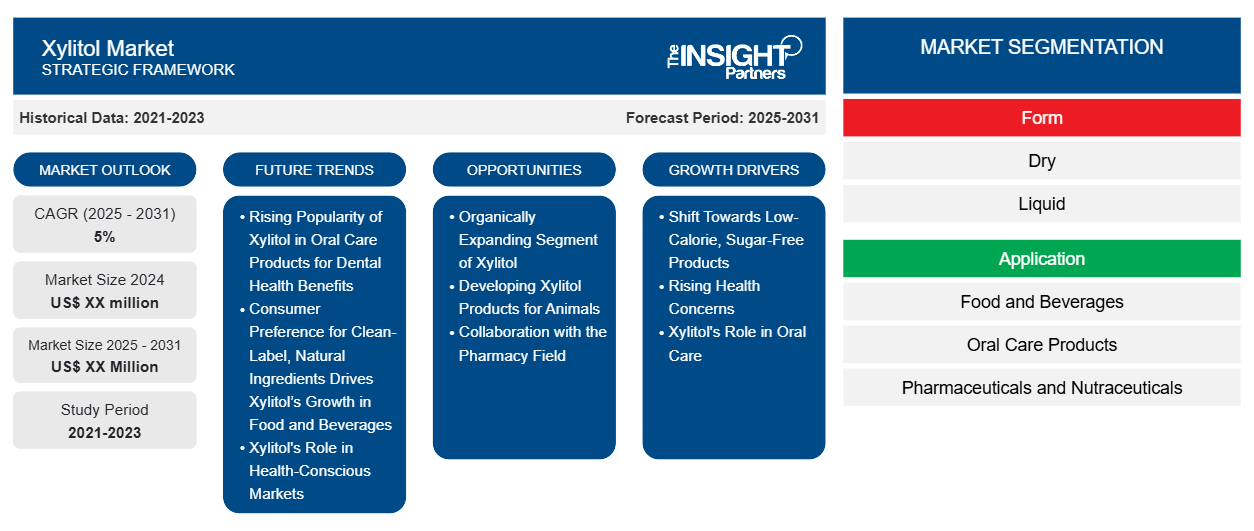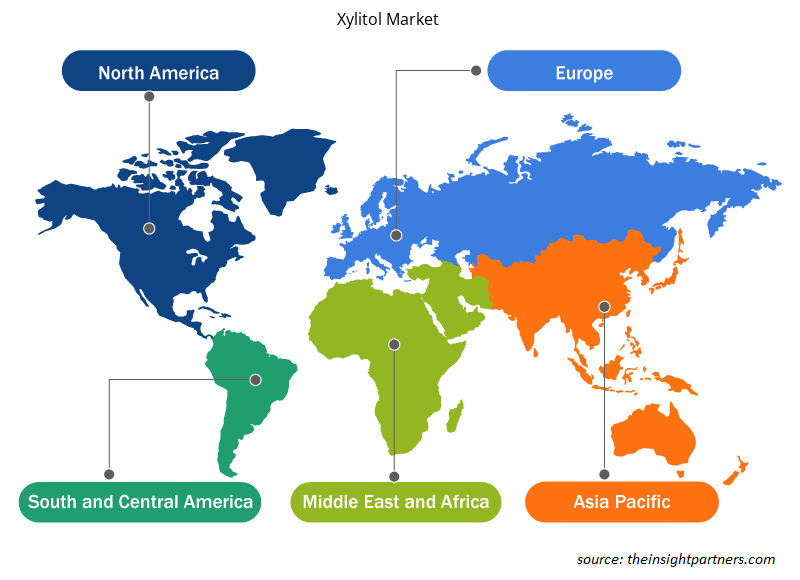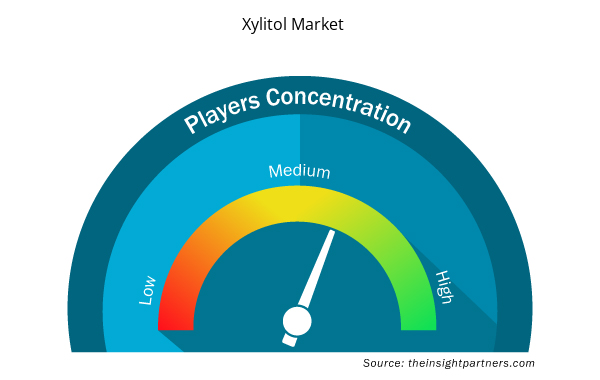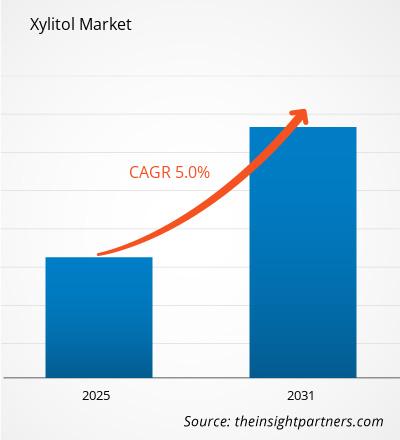Se espera que el mercado de xilitol registre una CAGR del 5% entre 2025 y 2031, con un tamaño de mercado que se expandirá de US$ XX millones en 2024 a US$ XX millones en 2031.
El informe está segmentado por formato (seco, líquido). Además, presenta un análisis basado en la aplicación [alimentos y bebidas (panadería y confitería, lácteos y postres congelados, bebidas, otros), productos para el cuidado bucal, productos farmacéuticos y nutracéuticos, cosméticos y artículos de tocador]. El análisis global se desglosa a nivel regional y por países principales. Geográficamente, el mercado se divide en América del Norte, Europa, Asia Pacífico, Oriente Medio y África, y América del Sur y América Central. El informe ofrece el valor en USD para el análisis y los segmentos mencionados.
Propósito del Informe
El informe "Mercado del Xilitol" de The Insight Partners busca describir el panorama actual y el crecimiento futuro, los principales factores impulsores, los desafíos y las oportunidades. Esto proporcionará información a diversas partes interesadas del negocio, como:
- Proveedores/Fabricantes de Tecnología: Para comprender la dinámica cambiante del mercado y conocer las oportunidades potenciales de crecimiento, lo que les permitirá tomar decisiones estratégicas informadas.
- Inversores: Realizar un análisis exhaustivo de tendencias respecto a la tasa de crecimiento del mercado, las proyecciones financieras del mercado y las oportunidades que existen en toda la cadena de valor.
- Organismos reguladores: Regular las políticas y las actividades policiales en el mercado con el objetivo de minimizar el abuso, preservar la confianza de los inversores y defender la integridad y estabilidad del mercado.
Segmentación del mercado del xilitol
Forma
- Seco
- Líquido
Solicitud
- Alimentos y bebidas
- Productos para el cuidado bucal
- Productos farmacéuticos y nutracéuticos
- Cosméticos y artículos de tocador
Personalice este informe según sus necesidades
Obtendrá personalización en cualquier informe, sin cargo, incluidas partes de este informe o análisis a nivel de país, paquete de datos de Excel, así como también grandes ofertas y descuentos para empresas emergentes y universidades.
Mercado del xilitol: perspectivas estratégicas

- Obtenga las principales tendencias clave del mercado de este informe.Esta muestra GRATUITA incluirá análisis de datos, desde tendencias del mercado hasta estimaciones y pronósticos.
Factores que impulsan el crecimiento del mercado del xilitol
- Cambio hacia productos bajos en calorías y sin azúcar: La preferencia por los productos sustitutivos bajos en calorías y sin azúcar está en aumento, lo que impulsa el consumo de xilitol. Cada vez más consumidores conocen sus beneficios, como sus bajos índices glucémicos, sus beneficios para la salud dental y su beneficio para las personas con diabetes, lo que ha impulsado su uso en alimentos, bebidas y productos de cuidado personal.
- Preocupaciones crecientes por la salud: Ante el aumento de problemas mundiales como la obesidad y la diabetes, la tendencia hacia los sustitutos del azúcar es cada vez mayor. El xilitol es un edulcorante natural muy bajo en calorías y con un índice glucémico bajo; por lo tanto, resulta cómodo para la mayoría de los fabricantes de productos alimenticios sin azúcar y bajos en calorías, lo que se traduce en un mayor y mejor crecimiento del mercado.Xylitol is a natural sweetener, which is very low in calories and has a low glycemic index; hence, it is comfortable for most manufacturers of sugar-free and reduced-calorie food products, resulting in more and better growth for the market.
- El papel del xilitol en el cuidado bucal: El xilitol es conocido por prevenir la caries dental y mejorar la salud bucal. Ahora que las personas son más conscientes de la higiene bucal, el xilitol se está incorporando a productos como pasta de dientes, chicles y enjuagues bucales; esto impulsa la demanda del mercado del cuidado bucal y amplía sus horizontes de mercado.
Tendencias futuras del mercado del xilitol
- Creciente popularidad del xilitol en productos de cuidado bucal por sus beneficios para la salud dental: La inclusión de xilitol en productos bucales como pasta de dientes, enjuague bucal y chicles se ha vuelto tendencia debido a sus beneficios dentales, como la prevención de caries y la reducción de la placa. A medida que más personas valoran la higiene bucal, crece el número de productos a base de xilitol para el cuidado dental.
- La preferencia del consumidor por ingredientes naturales y de etiqueta limpia impulsa el crecimiento del xilitol en alimentos y bebidas: Además, los consumidores ahora se inclinan por productos naturales y de etiqueta limpia al elegir un ingrediente como el xilitol en lugar de edulcorantes artificiales. Esto se evidencia en el creciente uso de xilitol en alimentos y bebidas de reciente introducción, así como en suplementos dietéticos, debido a la demanda de listas de ingredientes más saludables y claras.
- El papel del xilitol en los mercados que priorizan la salud: Tiene un bajo índice glucémico y es compatible con una dieta sin azúcar, lo que lo hace ideal para integrarlo en alimentos y bebidas funcionales. Cada vez más productos como caramelos sin azúcar, bebidas dietéticas y barras de proteínas utilizan xilitol como sustituto natural del azúcar, lo que promueve su crecimiento en los mercados que priorizan la salud.
Oportunidades de mercado del xilitol
- Segmento orgánico en expansión del xilitol: Esta creciente tendencia hacia los productos orgánicos y de etiqueta limpia ha resultado ser un gran impulso para los fabricantes de xilitol orgánico. Al introducir el xilitol orgánico en este segmento, las empresas pueden satisfacer la creciente demanda de alimentos, bebidas y productos de cuidado personal con ingredientes orgánicos, ofreciendo así una oferta atractiva para los consumidores preocupados por su salud.
- Desarrollo de productos de xilitol para animales: el xilitol está surgiendo entre los productos para el cuidado de mascotas, particularmente en formas de masticables dentales y golosinas dentales, y más allá de esos beneficios para proporcionar salud bucal a las mascotas, da a la conciencia de los dueños de mascotas una oportunidad de aumentar el mercado de xilitol para productos para mascotas, creando así ingresos adicionales para los fabricantes.
- Colaboración con el sector farmacéutico: La creciente demanda de edulcorantes bajos en calorías y sin índice glucémico en la industria farmacéutica representa una excelente oportunidad para el xilitol. Se pueden establecer colaboraciones con las compañías farmacéuticas involucradas en el uso de xilitol en la fabricación de jarabes, comprimidos o cualquier otro producto sin azúcar o bajo en azúcar dirigido a pacientes diabéticos y con otros trastornos metabólicos.
Perspectivas regionales del mercado del xilitol
Los analistas de Insight Partners han explicado detalladamente las tendencias y los factores regionales que influyen en el mercado del xilitol durante el período de pronóstico. Esta sección también analiza los segmentos y la geografía del mercado del xilitol en Norteamérica, Europa, Asia Pacífico, Oriente Medio y África, y Sudamérica y Centroamérica.

- Obtenga los datos regionales específicos para el mercado de xilitol
Alcance del informe de mercado de xilitol
| Atributo del informe | Detalles |
|---|---|
| Tamaño del mercado en 2024 | US$ XX millones |
| Tamaño del mercado en 2031 | US$ XX millones |
| CAGR global (2025-2031) | 5% |
| Datos históricos | 2021-2023 |
| Período de pronóstico | 2025-2031 |
| Segmentos cubiertos | Por formulario
|
| Regiones y países cubiertos | América del norte
|
| Líderes del mercado y perfiles de empresas clave |
|
Densidad de actores del mercado del xilitol: comprensión de su impacto en la dinámica empresarial
El mercado del xilitol está creciendo rápidamente, impulsado por la creciente demanda del usuario final debido a factores como la evolución de las preferencias de los consumidores, los avances tecnológicos y un mayor conocimiento de los beneficios del producto. A medida que aumenta la demanda, las empresas amplían su oferta, innovan para satisfacer las necesidades de los consumidores y aprovechan las tendencias emergentes, lo que impulsa aún más el crecimiento del mercado.
La densidad de actores del mercado se refiere a la distribución de empresas o compañías que operan en un mercado o sector en particular. Indica cuántos competidores (actores del mercado) hay en un mercado determinado en relación con su tamaño o valor total.
Las principales empresas que operan en el mercado del xilitol son:
- Cargill, Inc
- DuPont.
- Ingredión
- Merck KGaA,
- Tecnología alimentaria Mitsubishi Shoji
Descargo de responsabilidad : Las empresas enumeradas anteriormente no están clasificadas en ningún orden particular.

- Obtenga una descripción general de los principales actores clave del mercado de xilitol
Puntos clave de venta
- Cobertura integral: el informe cubre de manera integral el análisis de productos, servicios, tipos y usuarios finales del mercado de xilitol, proporcionando un panorama holístico.
- Análisis de expertos: el informe se compila con base en el conocimiento profundo de expertos y analistas de la industria.
- Información actualizada: El informe asegura relevancia comercial debido a su cobertura de información reciente y tendencias de datos.
- Opciones de personalización: este informe se puede personalizar para satisfacer los requisitos específicos del cliente y adaptarse adecuadamente a las estrategias comerciales.
Por lo tanto, el informe de investigación sobre el mercado del xilitol puede ayudar a descifrar y comprender el panorama de la industria y sus perspectivas de crecimiento. Si bien existen algunas preocupaciones válidas, las ventajas generales de este informe suelen superar las desventajas.
- Análisis histórico (2 años), año base, pronóstico (7 años) con CAGR
- Análisis PEST y FODA
- Tamaño del mercado Valor/volumen: global, regional, nacional
- Industria y panorama competitivo
- Conjunto de datos de Excel



Report Coverage
Revenue forecast, Company Analysis, Industry landscape, Growth factors, and Trends

Segment Covered
This text is related
to segments covered.

Regional Scope
North America, Europe, Asia Pacific, Middle East & Africa, South & Central America

Country Scope
This text is related
to country scope.
Preguntas frecuentes
The report can be delivered in PDF/Word format, we can also share excel data sheet based on request.
Based on geography, North America held the largest share of the xylitol market.
Cargill Incorporated, E. I. Du Pont De Nemours and Company, Ingredion Incorporated, Merck KGaA, Mitsubishi Shoji Foodtech, Novagreen Inc., Roquette Frères, Shandong Futaste Co., Thomson Biotech, ZuChem are the key players operating in the xylitol market.
On the basis of geography, the xylitol market is classified into North America, Europe, Asia Pacific, Middle East and Africa, and South and Central America.
Xylitol, being a natural sweetener with fewer calories and a low glycemic index, is a popular choice among manufacturers of sugar-free and reduced-calorie food products, enhancing its market growth.
The Xylitol Market is estimated to witness a CAGR of 5% from 2023 to 2031
Trends and growth analysis reports related to Chemicals and Materials : READ MORE..
1. Cargill, Inc
2. DuPont.
3. Ingredion
4. Merck KGaA,
5. Mitsubishi Shoji Foodtech
6. Novagreen Inc.
7. Roquette Frères
8. Shandong Futaste Co.
9. Thomson Biotech
10. ZuChem
The Insight Partners performs research in 4 major stages: Data Collection & Secondary Research, Primary Research, Data Analysis and Data Triangulation & Final Review.
- Data Collection and Secondary Research:
As a market research and consulting firm operating from a decade, we have published and advised several client across the globe. First step for any study will start with an assessment of currently available data and insights from existing reports. Further, historical and current market information is collected from Investor Presentations, Annual Reports, SEC Filings, etc., and other information related to company’s performance and market positioning are gathered from Paid Databases (Factiva, Hoovers, and Reuters) and various other publications available in public domain.
Several associations trade associates, technical forums, institutes, societies and organization are accessed to gain technical as well as market related insights through their publications such as research papers, blogs and press releases related to the studies are referred to get cues about the market. Further, white papers, journals, magazines, and other news articles published in last 3 years are scrutinized and analyzed to understand the current market trends.
- Primary Research:
The primarily interview analysis comprise of data obtained from industry participants interview and answers to survey questions gathered by in-house primary team.
For primary research, interviews are conducted with industry experts/CEOs/Marketing Managers/VPs/Subject Matter Experts from both demand and supply side to get a 360-degree view of the market. The primary team conducts several interviews based on the complexity of the markets to understand the various market trends and dynamics which makes research more credible and precise.
A typical research interview fulfils the following functions:
- Provides first-hand information on the market size, market trends, growth trends, competitive landscape, and outlook
- Validates and strengthens in-house secondary research findings
- Develops the analysis team’s expertise and market understanding
Primary research involves email interactions and telephone interviews for each market, category, segment, and sub-segment across geographies. The participants who typically take part in such a process include, but are not limited to:
- Industry participants: VPs, business development managers, market intelligence managers and national sales managers
- Outside experts: Valuation experts, research analysts and key opinion leaders specializing in the electronics and semiconductor industry.
Below is the breakup of our primary respondents by company, designation, and region:

Once we receive the confirmation from primary research sources or primary respondents, we finalize the base year market estimation and forecast the data as per the macroeconomic and microeconomic factors assessed during data collection.
- Data Analysis:
Once data is validated through both secondary as well as primary respondents, we finalize the market estimations by hypothesis formulation and factor analysis at regional and country level.
- Macro-Economic Factor Analysis:
We analyse macroeconomic indicators such the gross domestic product (GDP), increase in the demand for goods and services across industries, technological advancement, regional economic growth, governmental policies, the influence of COVID-19, PEST analysis, and other aspects. This analysis aids in setting benchmarks for various nations/regions and approximating market splits. Additionally, the general trend of the aforementioned components aid in determining the market's development possibilities.
- Country Level Data:
Various factors that are especially aligned to the country are taken into account to determine the market size for a certain area and country, including the presence of vendors, such as headquarters and offices, the country's GDP, demand patterns, and industry growth. To comprehend the market dynamics for the nation, a number of growth variables, inhibitors, application areas, and current market trends are researched. The aforementioned elements aid in determining the country's overall market's growth potential.
- Company Profile:
The “Table of Contents” is formulated by listing and analyzing more than 25 - 30 companies operating in the market ecosystem across geographies. However, we profile only 10 companies as a standard practice in our syndicate reports. These 10 companies comprise leading, emerging, and regional players. Nonetheless, our analysis is not restricted to the 10 listed companies, we also analyze other companies present in the market to develop a holistic view and understand the prevailing trends. The “Company Profiles” section in the report covers key facts, business description, products & services, financial information, SWOT analysis, and key developments. The financial information presented is extracted from the annual reports and official documents of the publicly listed companies. Upon collecting the information for the sections of respective companies, we verify them via various primary sources and then compile the data in respective company profiles. The company level information helps us in deriving the base number as well as in forecasting the market size.
- Developing Base Number:
Aggregation of sales statistics (2020-2022) and macro-economic factor, and other secondary and primary research insights are utilized to arrive at base number and related market shares for 2022. The data gaps are identified in this step and relevant market data is analyzed, collected from paid primary interviews or databases. On finalizing the base year market size, forecasts are developed on the basis of macro-economic, industry and market growth factors and company level analysis.
- Data Triangulation and Final Review:
The market findings and base year market size calculations are validated from supply as well as demand side. Demand side validations are based on macro-economic factor analysis and benchmarks for respective regions and countries. In case of supply side validations, revenues of major companies are estimated (in case not available) based on industry benchmark, approximate number of employees, product portfolio, and primary interviews revenues are gathered. Further revenue from target product/service segment is assessed to avoid overshooting of market statistics. In case of heavy deviations between supply and demand side values, all thes steps are repeated to achieve synchronization.
We follow an iterative model, wherein we share our research findings with Subject Matter Experts (SME’s) and Key Opinion Leaders (KOLs) until consensus view of the market is not formulated – this model negates any drastic deviation in the opinions of experts. Only validated and universally acceptable research findings are quoted in our reports.
We have important check points that we use to validate our research findings – which we call – data triangulation, where we validate the information, we generate from secondary sources with primary interviews and then we re-validate with our internal data bases and Subject matter experts. This comprehensive model enables us to deliver high quality, reliable data in shortest possible time.

 Obtenga una muestra gratuita de este informe
Obtenga una muestra gratuita de este informe